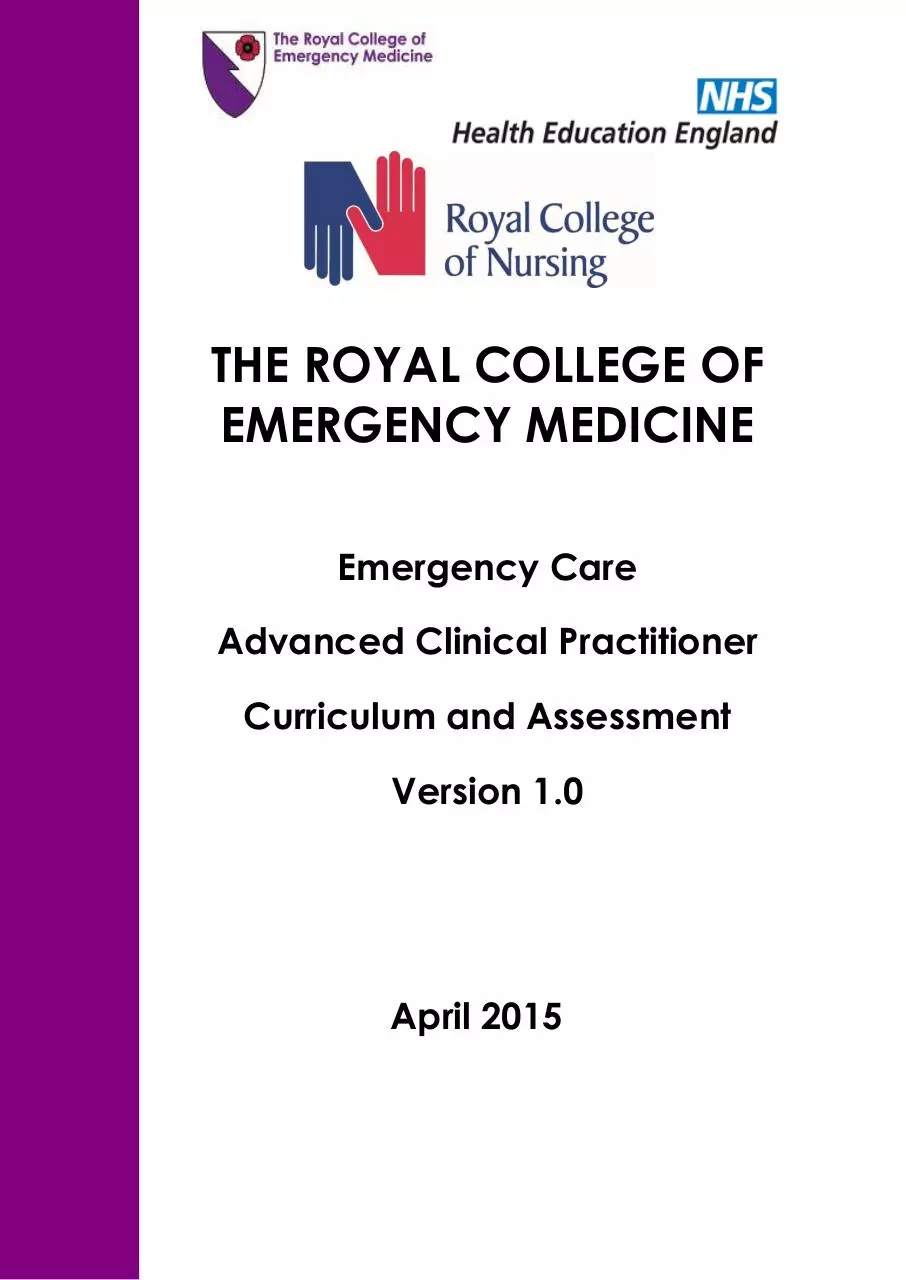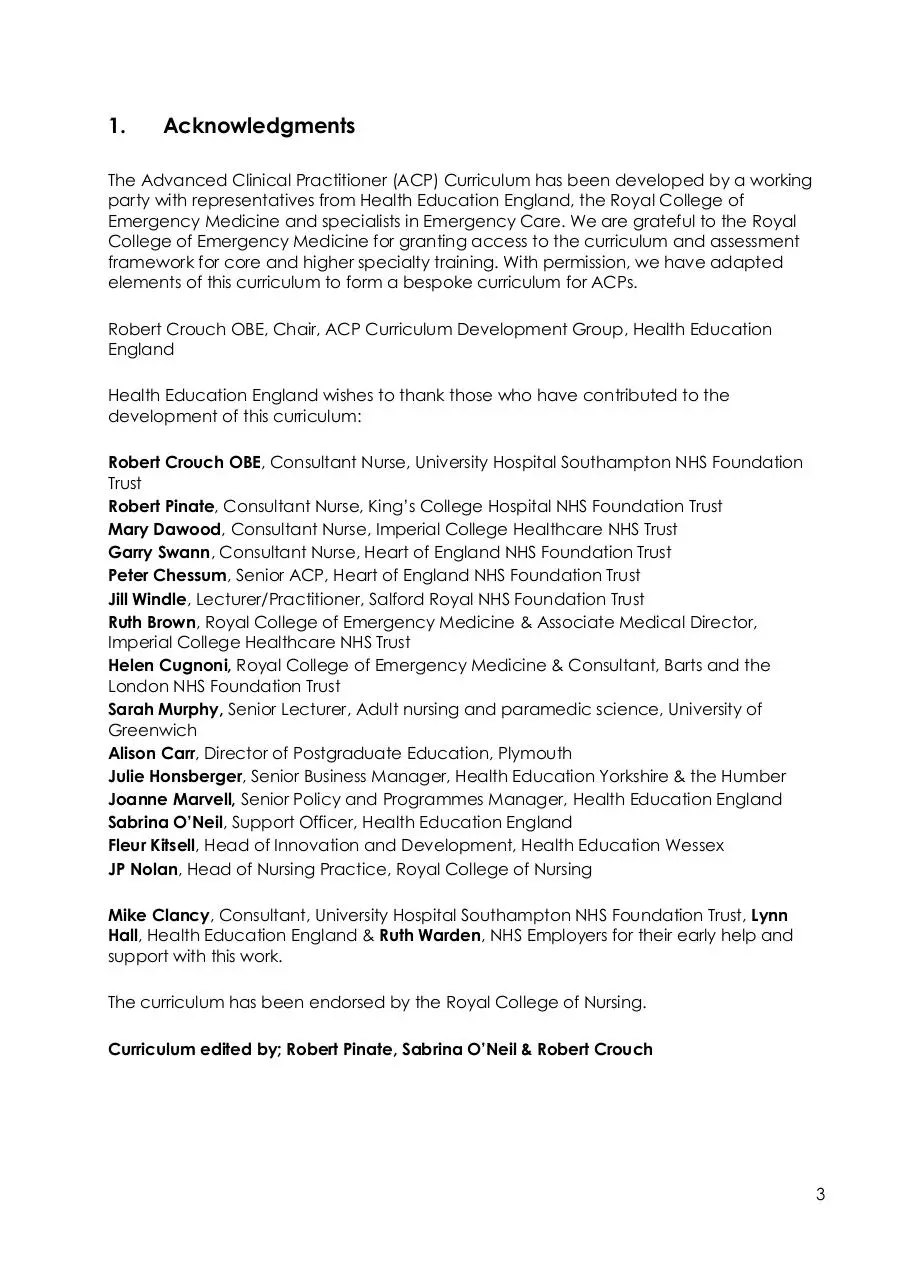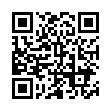RCEM ACP Curriculum & Assessment (PDF)
File information
Author: Robert Pinate
This PDF 1.5 document has been generated by Microsoft® Word 2010, and has been sent on pdf-archive.com on 15/10/2015 at 10:53, from IP address 188.223.x.x.
The current document download page has been viewed 2223 times.
File size: 2.99 MB (255 pages).
Privacy: public file





File preview
THE ROYAL COLLEGE OF
EMERGENCY MEDICINE
Emergency Care
Advanced Clinical Practitioner
Curriculum and Assessment
Version 1.0
April 2015
Contents:
1.
2.
3.
4.
Acknowledgements……………………………………………………………………….. 3
Introduction………………………………………………………………………………….. 4
Rationale……………………………………………………………………………………... 4
The training pathway………………………………………………………………………. 5
4.1. Entry level……………………………………………………………………………….. 5
4.2. The training programme……………………………………………………………... 5
4.2.1. ACP training…………………………………………………………………….. 5
4.2.2. Content of learning…………………………………………………………… 6
4.3. tACP Adult pathway………………………………………………………………….. 6
4.4. tACP Paediatric pathway…………………………………………………………… 6
4.5. tACP Adult and Paediatric pathway……………………………………………… 8
5. Teaching and learning methods………………………………………………………… 8
6. The e-portfolio and enrolment into the RCEM………………………………..………. 10
7. Assessment…………………………………………………………………………………... 10
7.1. The assessment system……………………………………………………………….. 10
7.2. Assessment blueprint…………………………………………………………………. 11
7.3. Assessment methods…………………………………………………………………. 11
7.4. Assessment frequency……………………………………………………………….. 14
7.5. Recommended 3 year framework………………………………………………... 15
7.5.1. Adult tACP training framework……………………………………………... 15
7.5.2. Paediatric tACP training framework………………………………………. 18
7.5.3. Adult and Paediatric tACP training framework…………………………. 21
8. Supervision and feedback……………………………………………………………….. 25
8.1. Supervision……………………………………………………………………………… 25
8.2. Appraisal………………………………………………………………………………... 26
8.3. Intended use of the curriculum by trainers and trainees……………………… 26
8.4. Recording progress in the e-portfolio……………………………………………… 27
8.5. Continuing Professional Development (CPD) and Revalidation……………. 27
9. The syllabus…………………………………………………………………………………... 28
9.1. Assessment methods glossary………………………………………………………. 28
9.2. Common competences…………………………………………………………….. 28
9.3. Major Presentations…………………………………………………………………… 115
9.4. Acute Presentations…………………………………………………………………... 125
9.5. Additional Major Trauma Presentations…………………………………………… 178
9.6. Additional Acute Presentations…………………………………………………….. 183
9.7. Paediatric Major and Acute Presentations………………………………………. 193
9.7.1. Paediatric Major Presentations………………………………………………194
9.7.2. Paediatric Acute Presentations…………………………………………….. 204
9.8. Airway Management…………………………………………………………………. 229
9.9. Procedural competences…………………………………………………………… 230
9.10. Paediatric Procedural competences……………………………………………. 230
9.11. Optional Anaesthetic competences…………………………………………….. 231
9.11.1. Procedural Sedation………………………………………………………….. 231
9.11.2. Aspects of regional anaesthesia…………………………………………… 233
10. Glossary of terms………………………………………………………………………….. 235
11. Appendices………………………………………………………………………………... 238
11.1. Appendix one: Adult tACP Curriculum - Years 1 – 3…………………………... 238
11.2. Appendix two: Paediatric tACP Curriculum - Years 1 – 3…………………….. 243
11.3. Appendix three: Adult and Paediatric tACP Curriculum - Years 1 – 3……... 249
2
1.
Acknowledgments
The Advanced Clinical Practitioner (ACP) Curriculum has been developed by a working
party with representatives from Health Education England, the Royal College of
Emergency Medicine and specialists in Emergency Care. We are grateful to the Royal
College of Emergency Medicine for granting access to the curriculum and assessment
framework for core and higher specialty training. With permission, we have adapted
elements of this curriculum to form a bespoke curriculum for ACPs.
Robert Crouch OBE, Chair, ACP Curriculum Development Group, Health Education
England
Health Education England wishes to thank those who have contributed to the
development of this curriculum:
Robert Crouch OBE, Consultant Nurse, University Hospital Southampton NHS Foundation
Trust
Robert Pinate, Consultant Nurse, King’s College Hospital NHS Foundation Trust
Mary Dawood, Consultant Nurse, Imperial College Healthcare NHS Trust
Garry Swann, Consultant Nurse, Heart of England NHS Foundation Trust
Peter Chessum, Senior ACP, Heart of England NHS Foundation Trust
Jill Windle, Lecturer/Practitioner, Salford Royal NHS Foundation Trust
Ruth Brown, Royal College of Emergency Medicine & Associate Medical Director,
Imperial College Healthcare NHS Trust
Helen Cugnoni, Royal College of Emergency Medicine & Consultant, Barts and the
London NHS Foundation Trust
Sarah Murphy, Senior Lecturer, Adult nursing and paramedic science, University of
Greenwich
Alison Carr, Director of Postgraduate Education, Plymouth
Julie Honsberger, Senior Business Manager, Health Education Yorkshire & the Humber
Joanne Marvell, Senior Policy and Programmes Manager, Health Education England
Sabrina O’Neil, Support Officer, Health Education England
Fleur Kitsell, Head of Innovation and Development, Health Education Wessex
JP Nolan, Head of Nursing Practice, Royal College of Nursing
Mike Clancy, Consultant, University Hospital Southampton NHS Foundation Trust, Lynn
Hall, Health Education England & Ruth Warden, NHS Employers for their early help and
support with this work.
The curriculum has been endorsed by the Royal College of Nursing.
Curriculum edited by; Robert Pinate, Sabrina O’Neil & Robert Crouch
3
2.
Introduction
The role of the Advanced Clinical Practitioner (ACP) is relatively new. Working as part of
the multidisciplinary team they make an important contribution to Emergency Medicine
(EM). Through collaboration between Health Education England (HEE) and the Royal
College of Emergency Medicine (RCEM), the College have granted access to the
specialty training curriculum for EM. With permission, we have adapted the curriculum
identifying common competencies, acute presentations and procedural skills to provide
a framework for ACPs in EM. The following competences are considered core for EM.
Trainee ACPs (tACP) are expected to have attained at least level 2 competence in all
common competences and successfully achieved all the major and acute
competences and practical procedures, as set out in the curriculum, by the time of
completion of their programme and application for credentialing as an ACP.
ACPs are able to look after patients with a wide range of pathologies from the lifethreatening to the self-limiting.
•
They are able to identify the critically ill and injured, providing safe and
effective immediate care.
•
They have expertise in resuscitation and skilled in the practical procedures
needed.
•
They establish the diagnosis and differential diagnosis rapidly, and initiate or
plan for definitive care.
•
They work with all the in-patient specialties as well as primary care and prehospital services.
•
They are able to correctly identify who needs admission and who can be
safely sent home.
This curriculum sets out the intended aims and objectives, content, experiences,
outcomes and processes of the educational program intended to provide ACPs with the
knowledge and expertise to be safe, expert practitioners functioning within the
multidisciplinary EM team.
Skills and behaviours that Emergency Clinicians need to be effective and to
communicate with patients, carers and their families, and how these will be assessed are
mapped out in the curriculum.
3.
Rationale
The purposes of this curriculum are to define the process of training and competence
required for:
•
•
Successful completion of ACP training in EM.
The successful completion of additional paediatric competences for ACPs
working with children.
Duration of training is covered in more detail in section 4.2.1
4
4.
The training pathway
Whilst this curriculum sets out the competences and training required for credentialing as
an ACP, it is recognised that local training, education and development pathways may
differ. The following training pathway is therefore recommended as a common basis for
ACP training.
In developing this curriculum the HEE ACP working group recognised that practitioners
may be based in adult or paediatric only settings and in addition that some practitioners
may be working in combined adult and paediatric settings where they would be
expected to see patients of any age. In order to ensure practitioners could qualify as an
ACP in their specific area of work we have developed three pathways:
•
•
•
tACP - Adult
tACP - Paediatric
tACP - Adult and Paediatric
The three trainee pathways have their own distinct recommended training programme
which is detailed further in sections 4.3 – 4.5.
4.1.
Entry level
The Curriculum Development Committee considered that suitable entry time to begin
the ACP training to be 5 years post registration with a minimum of 3 years emergency
care experience. All trainees and ACPs must be registered with either the NMC or HCPC.
All time periods contained within this document refer to full-time equivalent.
4.2.
The training program
4.2.1.
ACP training
The ACP training program would normally be expected to take 3 years and is made up
of two key components:
1.
Educational preparation in advanced practice at Masters Level:
Successful completion of educational programme at Masters (Level 7) in
advanced practice with a minimum award of Post Graduate Diploma (Pg.
Dip). This must include core modules in:
• History taking and physical assessment
• Pharmacology and prescribing (All tACPs eligible to prescribe
independently must hold this qualification at credentialing)
• Diagnostic interpretation
• Clinical decision making
2.
Successful completion of the ACP curriculum:
ACPs are expected to have attained at least level 2 competence in all
common competences and successfully achieved all the major and acute
competences and practical procedures, as set out in the curriculum.
5
4.2.2.
Content of learning
This curriculum lists the specific knowledge, skills and behaviours to be attained at each
stage of training. These are presented in three parts:
•
Common competences.
This describes the generic competences that should be achieved within the
programme.
•
Symptom competences.
These define the knowledge, skills and behaviours required for each of the
major presentations and acute presentations that will be encountered by
ACPs. These presentations have been based on Emergency Department
audits of activity. The investigation competences, where appropriate, are
listed alongside these presentations.
•
Procedural competences are listed. The procedural competences which
should be acquired are described. It is recognised that many tACPs will
already have achieved competence is some of these procedural skills in the
course of their professional career.
4.3.
tACP - Adult pathway
For tACPs who will be expected to see adult patients only. Successful completion of the
curriculum must include (see appendix 1):
•
•
•
•
•
•
•
All common competences (CC1 – CC25) to at least level 2 descriptor
Major presentations, relevant to the organisation in which the practitioner
works (CMP1 – CMP6)
All acute presentations (CAP1 – CAP38)
Procedural competences, relevant to the organisation in which the
practitioner works
Airway management competency (A5B)
Additional major trauma competences, relevant to the organisation in which
the practitioner works (C3AP1a – C3AP1e)
All additional acute presentations (C3AP2 – C3AP9)
May include:
•
4.4.
Optional anaesthetic competences:
O3 – Procedural sedation
O4 – Aspects of regional anaesthesia
tACP - Paediatric pathway:
The paediatric tACP training programme is designed for those practitioners who will only
see children and young people as an ACP.
The RCEM ACCS EM training programme is designed around clinicians spending time in
6
both adult and children settings where the paediatric component comes in the 3rd year
of training. There is therefore significant proportions of the curriculum which would be
missed were the tACP in paediatrics only to complete paediatric specific competences.
The HEE ACP working group has therefore developed a paediatric training pathway
which combines the adult and paediatric curricula where many of the competences set
out in adult practice are applicable to children.
For tACPs working in settings where they will see both adults and children, they must
complete the adult and paediatric ACP training detailed in 4.5.
The paediatric tACP must successfully complete the following (see appendix 2):
•
•
•
•
All common competences (CC1 – CC25) to at least level 2 descriptor.
All paediatric major presentations (PMP1 – PMP6)
The Major Presentations (CMP1 – CMP6) should be combined with the
paediatric specific competences as they provide greater detail and depth in
relation to the presentation. i.e. paediatric tACPs will complete PMP1 –
Anaphylaxis and CMP1 – Anaphylaxis (further detail in section 7.5.2 and
appendix two)
The following major presentation is not expected for tACPs only seeing children
given their specific relevance to adult practice:
CMP4 – Septic patient (adequately covered in PMP5 – the shocked child)
All paediatric acute presentations (PAP1 – PAP19)
All acute presentations relevant to paediatric practice (CAP1 – CAP38)
The Acute Presentations relevant to paediatric practice should be completed
or combined with the appropriate paediatric acute presentation as they
provide greater detail and depth i.e. Paediatric tACPs will complete PAP1 –
Abdominal pain and CAP1 – Abdominal pain.
There are acute presentations that are not expected for tACPs only seeing
children given their specific relevance to adult practice or they are
adequately covered in the paediatric acute presentations, see appendix 2 for
details:
•
•
•
•
•
All paediatric procedures (PEMP1 – PEMP5) relevant to the organisation in
which the practitioner works
Procedural competences, relevant to paediatric practice and the
organisation in which the practitioner works
Airway management competency (A5B)
Additional major trauma competences, relevant to the organisation in which
the practitioner works (C3AP1a – C3AP1e)
All additional acute presentations as detailed in appendix 2(C3AP2 – C3AP9)
May include:
•
Optional anaesthetic competences:
O3 – Procedural sedation
7
4.5.
tACP - Adult and Paediatric pathway:
The adult and paediatric pathway has been designed akin to the ACCS EM model
where the majority of paediatric practice is focused on the 3rd year of training. The
following three year programme is a guide and it is recognised practitioners may have
the opportunity to work in both adult and paediatric areas concurrently. However, tACPs
may benefit from a focused period of paediatric practice and this programme reflects
that approach.
Successful completion of the curriculum must include (see appendix 3):
•
•
•
•
•
•
•
•
•
•
All common competences (CC1 – CC25) to at least level 2 descriptor.
Major presentations, relevant to the organisation in which the practitioner
works (CMP1 – CMP6)
All paediatric major presentations (PMP1 – PMP6)
All acute presentations (CAP1 – CAP38)
All paediatric acute presentations (PAP1 – PAP19)
Procedural competences, relevant to the organisation in which the
practitioner works
All paediatric procedures (PEMP1 – PEMP5) relevant to the organisation in
which the practitioner works
Airway management competency (A5B)
Additional major trauma competences, relevant to the organisation in which
the practitioner works (C3AP1a – C3AP1e) in adults and paediatrics
All additional acute presentations (C3AP2 – C3AP9)
May include:
•
5.
Optional anaesthetic competences:
O3 – Procedural sedation
O4 – Aspects of regional anaesthesia
Teaching and learning methods:
The curriculum will be delivered through a variety of learning situations ranging from
formal teaching programmes to experiential learning.
Types of learning situations:
Learning with peers
Working alongside peers, discussing cases, small group teaching and examination
preparation.
Workplace based experiential learning
This is where the majority of learning takes place, with senior clinician supervised care
(review of patients, note keeping, initial management, investigation and referral), with
progressive increase in responsibility as competence and experience is gained. Such
learning can occur across the following settings:
8
•
•
•
•
•
•
•
•
The Resuscitation room
The Majors area with trolley bound patients
The Ambulatory area
The Observation Ward/ Clinical Decision Unit
The Paediatric area
Follow-up of patients on in-patient wards/ ICU
Liaison and discussion of cases with specialists
Working closely with multidisciplinary teams e.g. mental health, discharge
support teams
Formal post graduate teaching
The content of the advanced practice Masters Level programme will be determined by
the provider institution. In addition the tACP should actively seek out further opportunities
in the work place such as:
•
•
•
•
•
•
•
•
•
•
A programme of regular teaching sessions to cohorts of medical trainees (local
and Local Education and Training Board/deanery/regional) designed to cover
aspects of the curriculum.
Case presentations
M&M meetings
Journal clubs
Research and audit projects
Lectures and small group teaching
Clinical skills - use of simulation
Critical appraisal exercises
Joint specialty meetings
Life support courses
Independent self-directed learning
•
•
•
•
•
Reading, including the use of web-based materials such as the RCEM Learning
platform.
Maintenance of personal portfolio (self-assessment, reflective writing, personal
development plan)
Maintenance of airway log book and practical procedures
Audit and research projects
Reading journals
RCEM Learning
The RCEM has developed an eLearning strategy which is available on one platform:
www.rcemlearning.co.uk
This is available to all tACPs who are members of the RCEM.
The RCEM regards the development of its eLearning strategy as an important part of its
training programme. The mapping of the eLearning to the College curriculum and
linkage to the workshops (with dedicated web-based materials) as well as workplace
9
Download RCEM ACP Curriculum & Assessment
RCEM ACP Curriculum & Assessment.pdf (PDF, 2.99 MB)
Download PDF
Share this file on social networks
Link to this page
Permanent link
Use the permanent link to the download page to share your document on Facebook, Twitter, LinkedIn, or directly with a contact by e-Mail, Messenger, Whatsapp, Line..
Short link
Use the short link to share your document on Twitter or by text message (SMS)
HTML Code
Copy the following HTML code to share your document on a Website or Blog
QR Code to this page

This file has been shared publicly by a user of PDF Archive.
Document ID: 0000308330.